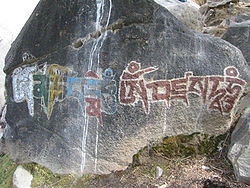- Écriture tibétaine
-
Tibétain Caractéristiques Type Alphasyllabaire Langue(s) Tibétain
Dzongkha
LadakhiHistorique Époque c. 650–present Créateur Thonmi Sambhota Système(s) parent(s) Alphabet linéaire [a]
Alphabet phénicien [a]
Alphabet araméen [a]
Brāhmī
Gupta
Siddhaṃ
TibétainSystème(s) apparenté(s) Limbu
Lepcha
PhagspaEncodage Unicode U+0F00-U+0FFF ISO 15924 Tibt L'écriture tibétaine est un alphasyllabaire d'origine indienne, de la famille des écritures brahmiques, utilisé pour écrire le tibétain ainsi que le dzongkha, le ladakhi et parfois le balti. Sa forme imprimée est appelée écriture uchen (en tibétain : དབུ་ཅན་ ; Wylie : dbu-can « avec une tête) », tandis que la forme cursive manuscrite quotidienne est appelé écriture umé (en tibétain : དབུ་མེད་ ; Wylie : dbu-med « sans tête »). L'écriture est liée de près à l'identité ethnique tibétaine au sens large. Ce système d'écriture a été aussi utilisé pour les langues tibétaines non seulement au Tibet, mais aussi au Bhoutan et dans des parties de l'Inde, du Népal et du Pakistan (Chamberlain 2008).
L'écriture est romanisée de multiples façons[1]. Cet article emploie la translittération Wylie.
Sommaire
Histoire
 Le texte polychrome à gauche est le premier mantra du bouddhisme tibétain, en sanskrit Oṃ Maṇi Padme Hūṃ (en tibétain : ༀམནིཔདྨེཧཱུྃ ; Wylie : oMmanipad+mehU~M). Le texte monochrome à droite est en sanskrit "Oṃ Vajrasattva Hūm" (tibétain : ༀབཛྲསཏྭཧཱུཾ ; Wylie: oM badzrasatwa hUM), une invocation à l'incarnation de la pureté originelle.
Le texte polychrome à gauche est le premier mantra du bouddhisme tibétain, en sanskrit Oṃ Maṇi Padme Hūṃ (en tibétain : ༀམནིཔདྨེཧཱུྃ ; Wylie : oMmanipad+mehU~M). Le texte monochrome à droite est en sanskrit "Oṃ Vajrasattva Hūm" (tibétain : ༀབཛྲསཏྭཧཱུཾ ; Wylie: oM badzrasatwa hUM), une invocation à l'incarnation de la pureté originelle.
La tradition dit que l'alphasyllabaire tibétain fut créé au VIIe siècle par Thonmi Sambhota, un ministre du roi Songtsen Gampo (33e roi du Tibet), à partir de l'alphasyllabaire indien brahmi, écriture qui donnera naissance à celle de plusieurs autres langues de l'Inde.
Songtsen Gampo envoya 17 étudiants tibétains en Inde pour maîtriser ses langues et par elles, le bouddhisme. Thonmi Sambhota, le plus célèbre de ces étudiants, retourna au Tibet après avoir maîtrisé le sanscrit et s'être intié au bouddhisme. Pourtant, Thonmi Sambhota semble être un personnage légendaire, son nom n'apparaît dans les textes tibétains qu'au XIIIe siècle. En se fondant sur des manuscrits en brahmi et gupta, il aurait conçut l'alphabet, établit la grammaire tibétaine, et y traduit du sanscrit, pour la première fois dans l'histoire du Tibet, plusieurs textes bouddhistes importants[2].
Voir aussi
Notes
- Voir par exemple [1] [2]
- The Three Dharma Kings of Tibet
Références
- Beyer, Stephan V. (1993). The Classical Tibetan Langage. Reprinted by Delhi: Sri Satguru.
- Chamberlain, Bradford Lynn. 2008. Script sélection for Tibetan-related langages in multiscriptal environments. International Journal of the Sociology of Langage 192:117-132.
- Csoma de Kőrös, Alexander (1983). A Grammar of the Tibetan Langage. Reprinted by Delhi: Sri Satguru.
- (1980-1982). Sanskrit-Tibetan-English Vocabulary. 2 vols. Reprinted by Delhi: Sri Satguru.
- Sarat Chandra Das (1996). An Introduction to the Grammar of the Tibetan Langage. Reprinted by Delhi: Motilal Banarsidass.
- Heinrich August Jäschke (1989). Tibetan Grammar. Corrected by Sunil Gupta. Reprinted by Delhi: Sri Satguru.
Liens externes
- Tibetan Calligraphy - how to write the Tibetan script.
- Unicode area U0F00-U0FFF, Tibetan script (162KB)
- An index of documents related to the Encoding of Tibetan in the Unicode / ISO 10646 standards
- Jomolhari Font - Unicode compatible. Download
- 2 fonts - not Unicode compatible.
- 2 fonts: 1 Macintosh, not Unicode compatible.
- Origins of tibetan calligraphy: History of tibetan script and guide to tibetan script.
- Omniglot's Guide to the Tibetan writing system
- Tibetan & Himalayan Fonts - THDL articles on Unicode font issues; free cross-platform OpenType fonts - Unicode compatible.
- Elements of The Tibetan writing system.
- Introduction to Tibetan Orthography, at Kuro5hin
- Free Tibetan Fonts Project
 La plaque d'immatriculation d'une voiture du Jammu-et-Cachemire, en caractères romains et tibétains.
La plaque d'immatriculation d'une voiture du Jammu-et-Cachemire, en caractères romains et tibétains.
Wikimedia Foundation. 2010.
